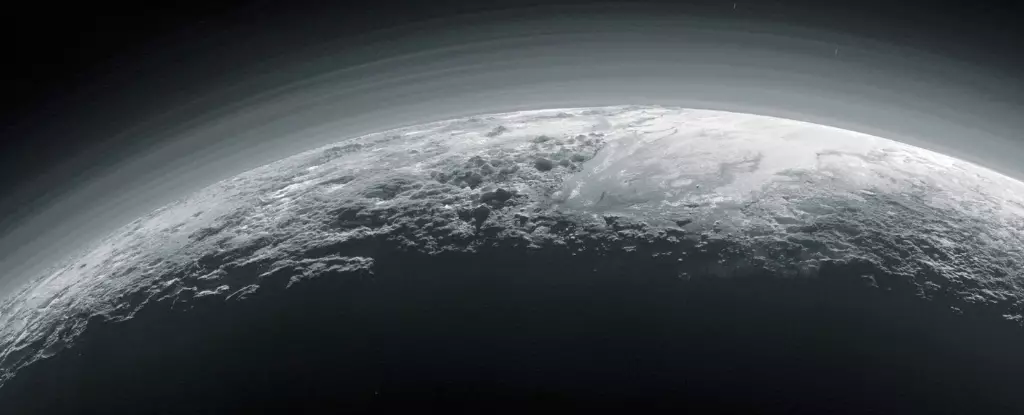In July 2015, humanity took an unprecedented leap in understanding our outer solar system with the New Horizons spacecraft’s monumental flyby of Pluto and its largest moon, Charon. What unfolded was not just a glimpse of a distant dwarf planet, but an entirely redefined narrative of planetary dynamics and atmospheres. As these celestial bodies revealed their complexity and unexpected characteristics, scientists began to speculate about what lay in the depths of Pluto’s atmosphere. Fast forward to the advancements in 2022 and 2023, and the James Webb Space Telescope (JWST) has unveiled groundbreaking revelations about Pluto’s atmosphere that surpass expectations and beckon a new era of planetary science.
Hazy Atmospheres: A Unique Cocktail of Gases
Pluto’s atmosphere is no ordinary gaseous envelope; it consists of a unique blend of nitrogen, methane, and carbon monoxide. These elements come together to create a complex haze that behaves in ways previously unknown. Unlike other planetary atmospheres in our solar system, which primarily rely on gas molecules for their radiative balance, Pluto’s atmosphere seems to draw its energy equilibrium largely from particulate haze. This paradigm-shifting understanding connects intricately with the work of Xi Zhang from the University of California – Santa Cruz, whose bold hypothesis in 2017 prompted the JWST missions designed to probe Pluto’s atmospherics.
Zhang and his team’s predictions laid the groundwork for the JWST’s observations, focusing specifically on how the haze particles modulate heat retention and emission in Pluto’s atmosphere. This interplay leads to energy dynamics that are not observed on other celestial objects—a characteristic that further establishes Pluto as an anomaly in our solar system.
The Role of Haze: Shaping Atmospheric Dynamics
The initial data from JWST indicated that as Pluto experiences fluctuations in temperature, its haze particles engage in a dance of rising and falling, responding dynamically to thermal changes. This feature is critical; it highlights that the hazes aren’t mere byproducts but active components influencing atmospheric behavior and, consequently, global temperature distributions. By emitting mid-infrared radiation when heated, these haze particles play a vital role in regulating Pluto’s thermal inertia and emissivity, revealing how unique atmospheric interactions can govern planetary systems on scales yet to be fully understood.
The JWST’s ability to capture detailed spectral data has allowed scientists to monitor these fine contributions more precisely than ever before, providing an expansive picture of Pluto’s environmental variables. This has become especially critical when analyzing the leading theories behind how ice migrations occur across the dwarf planet’s surface—a phenomenon dramatically unique to Pluto.
Seasonal Mysteries: The Transfer of Ice Between Worlds
Not only does Pluto engage in intricate atmospheric cycles, but it also showcases seasonal behavior that stands out starkly in our solar system. Observations reveal that Pluto’s surface is subject to continual redistribution of volatile ices—some even migrating to Charon—and this transfer suggests a complex and active interplay of material between the two bodies. As ice deposits shift with the seasons, scientists have begun to appreciate how surface phenomena can drive dramatic changes in atmospheric conditions.
The JWST’s targeted observations of Pluto in 2023 have been monumental in revealing how these cycling ice dynamics occur in real-time, challenging long-held assumptions and showcasing a vibrant, active world that is far from static. The data suggests that Pluto serves as an environmental laboratory, enabling researchers to study how transient, volatile materials contribute to atmospheric conditions, forming comparisons with icy satellites of other planets, like Titan and Triton.
Insights into Earth’s Cosmic Origins
Pluto’s peculiar atmospheric characteristics also spark intriguing questions about Earth’s own past. Zhang posits that by understanding Pluto’s haze and complex interactions within its atmosphere, scientists may glean insights into Earth’s primordial atmospheric conditions. The notion that early Earth had nitrogen-rich environments filled with hydrocarbons ignites speculation regarding the cosmic history shared by distant celestial bodies.
The burgeoning field of astrochemistry stands to gain immensely from these revelations. As researchers continue to unravel the complexities of haze within Pluto’s atmosphere, we may uncover new pathways for understanding habitability and the origins of life in extraterrestrial contexts. In this sense, the JWST does more than simply observe; it opens doors to foster dialogue about the very nature of planetary evolution and life-sustaining conditions.
As scientists embark on this exciting journey of discovery with the JWST, Pluto remains a beacon of hope and intrigue. Its unique figures challenge our preconceived notions of planetary atmospheres, enhancing our quest for knowledge about where we come from and what lies beyond our solar neighborhood. The implications reverberate through astronomy and planetary studies, redefining our place within the cosmic mosaic.


Leave a Reply